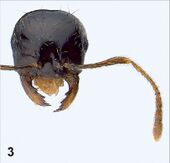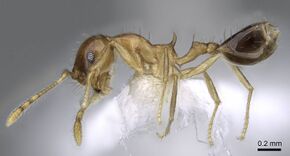Key to Asian Recurvidris
This worker key is based on: Jaitrong, W., Tokeeree, Y., Pitaktunsakul, P. 2019. A new species of the ant genus Recurvidris Bolton, 1992 (Hymenoptera, Formicidae, Myrmicinae) from Thailand. ZooKeys 830: 53-61 (DOI 10.3897/zookeys.830.31147).
You may also be interested in
1
- Masticatory margin of mandible with 4 or 5 teeth, basal (fourth or fifth) tooth distinctly larger than preceding tooth, acute to bidenticulate; head behind level of frontal lobes sculptured (opaque, reticulate, reticulate-punctate); propodeal declivity with narrow infradental lamella or ridge linking propodeal spine to metapleural lobe . . . . . 2
- Masticatory margin of mandible with 4 teeth, basal (fourth) tooth at most only slightly larger than third; head behind level of frontal lobes unsculptured; propodeal declivity lacking infradental lamella or ridge linking propodeal spine to metapleural lobe . . . . . 7
2
return to couplet #1
- Masticatory margin of mandible with 5 teeth . . . . . 3
- Masticatory margin of mandible with 4 teeth . . . . . 4
3
return to couplet #2
- Dorsum of head finely and densely reticulate-punctate everywhere, dull and opaque; disc of pronotum finely and densely sculptured; subpetiolar process as a short tooth; small species (HW 0.39, see Bolton 1992) . . . . . Recurvidris williami
- Dorsum of head only with very fine superficially reticulate patterning, glossy; disc of pronotum glassy smooth; subpetiolar process as a long spine; large species (HW 0.45–0.56, see Bolton 1992; Jaitrong and Wiwatwitaya 2015) . . . . . Recurvidris browni
4
return to couplet #2
- Basal tooth of mandible acute apically . . . . . 5
- Basal tooth of mandible bidenticulate apically, may appear as abruptly truncated in worn mandible . . . . . 6
5
return to couplet #4
- Propodeal dorsum with only faint superficial sculpture and with a pair of short decumbent hairs . . . . . Recurvidris pickburni
- Propodeal dorsum with fine dense reticulate-rugulae and without a pair of short decumbent hairs (Fig. 1D) . . . . . Recurvidris nuwa
6
return to couplet #4
- In profile view, propodeal spine and petiolar peduncle relatively short and stout (Figure 7); with head in full-face view, occipital corner narrowly rounded; postpetiole in dorsal view 1.6–1.8 times as broad as petiolar node (Bolton, 1992) . . . . . Recurvidris recurvispinosa
- In profile view, propodeal spine and petiolar peduncle relatively long and narrow (Figure 8); with head in full-face view, occipital corner broadly rounded; postpetiole in dorsal view 1.3–1.4 times as broad as petiolar node (Bolton, 1992) . . . . . Recurvidris hebe
7
return to couplet #1
- Propodeal dorsum with 1–2 standing (erect) hairs . . . . . 8
- Propodeal dorsum with 1–2 pairs of very short decumbent or appressed hairs, without standing hairs . . . . . 10
8
return to couplet #7
- Head and gaster dark brown, much darker than the yellowish mesosoma . . . . . Recurvidris proles
- Body color uniformly yellow . . . . . 9
9
return to couplet #8
- Basal margin of mandible unarmed; head relatively long (CI < 90) . . . . . Recurvidris glabriceps
- Basal margin of mandible armed with a small tooth which is widely separated from basal tooth; head relatively short and broad (CI ≥ 100) . . . . . Recurvidris chanapaithooni
10
return to couplet #7
- Body color uniformly blackish brown; in profile propodeal spine broad at base . . . . . Recurvidris nigrans
- Body yellowish brown; in profile propodeal spine narrow at base . . . . . 11
11
return to couplet #10
- Entire propodeum and dorsum of petiolar peduncle smooth and shiny; propodeal spine long, slightly longer than longest pronotal hairs . . . . . Recurvidris lekakuli
- Dorsum of propodeum superficially sculptured; dorsum of petiolar peduncle finely reticulate; propodeal spine short, shorter than longest pronotal hairs . . . . . Recurvidris kemneri



















